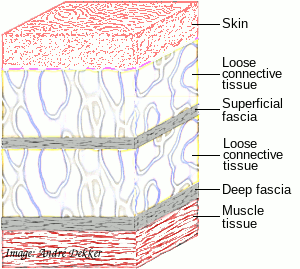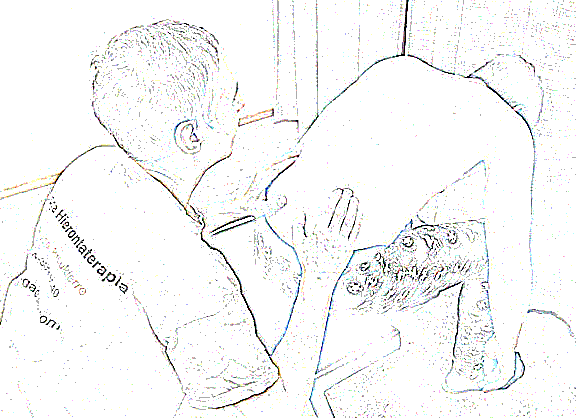Fascia therapy
What is fascia?
![Cross-section of subcutis [Cross-section of the subcutis]](hypodermis-en.gif)

The fascia is the connective tissue that surrounds and connects every muscle and organ, forming continuity throughout the body. The fascia around individual muscles is also known as muscle sheaths. The adjacent picture shows a simplified cross-section of the subcutaneous tissue of the body. From top to bottom you see:
- the skin;
- a layer of loose connective tissue;
- the superficial fascia;
- a layer of loose connective tissue;
- the deep fascia;
- muscle tissue.
Formerly, the fascia was thought to be just a kind of packing material. Therefore, most anatomy textbooks only depict the fascia in a very limited way. But in recent years, it has been discovered that the fascia performs many indispensable functions in the body. The fascia is an organ in itself. The fascia plays an important role in the power transmission of muscles. Much of the body’s metabolism and fluid transport passes through the fascia. The fascia contains blood and lymph vessels and is particularly rich in nerves. All external forces acting on the body and all forces produced by the muscles cause tension in the fascia, which propagates from one place to another over certain long ‘lines of pull’. The free nerve endings in the fascia perceive this tension and allow the contractions of different muscles to be aligned. The nerve endings in the fascia also provide the brain with information about the state of the adjacent tissue. When the fascia does not function properly, it interferes with the functioning of the whole body.
The composition of the fascia
The fascia consists of several layers or membranes. Each membrane consists of collagen and elastin fibres and fluid. The ratio between the different kinds of fibres and also the amount and composition of the fluid determine the mechanical properties of the fascia. The membranes are connected by a network of elastin and collagen fibres aka loose connective tissue, which allows movement between the membranes within certain limits. This network includes fat cells, interstitial fluid, blood and lymph vessels and nerves. The same vessels and nerves also run through the membranes of the fascia. When this system functions normally, all structures within it can glide past each other without friction. This allows the body to move smoothly and without pain.
The treatment of the fascia
The more that has become known about the functioning of the fascia, the more gentle the treatment methods have become. Initially, one tried to stretch the fibres in the fascia with a lot of force. But according to recent research, movement restrictions in the fascia and entrapment of nerves are usually caused by ‘drying out’ of the fascia or a change in the composition of the fluid. Gentle techniques aimed at stimulating fluid transport in the fascia are often more successful than forced stretching and more comfortable for the client.
Because the fascia and muscles are in close contact with each other, it is impossible to treat them separately. The difference between classical and fascial massage lies mainly in the depth of the massage. Classical massage treats muscles through the fascia, while fascial massage stays more on the surface of the muscles. This does not mean that fascial massage always stays right under the skin. Some of the fascia lies deeper than where most classical massage therapists have learned to treat.
In my experience, encouraging tissues to change leads to a better treatment outcome than forcing them. This is why I have abandoned all ‘aggressive’ treatment methods. Today, I mainly use techniques from the following treatment methods:
The following is a more detailed description of these methods:
Structural Integration
![Lateral raphe [Treatment of the lateral raphe]](../pictures/lat-raphe.jpg)

Structural Integration, which is also known as Rolfing®, is a method to free the body from excess tension patterns and bring it into balance with gravity. A full Structural Integration treatment consists of 10 or 12 sessions, in which different parts of the body are treated in a set order. The most commonly used technique is the following: The therapist contacts the tissue to be mobilized with his or her hands and then asks the client to move in a certain pattern. During the client’s movement, the therapist stretches or shifts the tissue or loosens it from any adhered tissues. I have completed two of the three phases of the structural integrator training. The second phase, which I completed in 2016, teaches an abbreviated version of the structural integration treatment, then called Functional Fascial Release and nowadays the ATSI 3-Series. Nowadays, I still use techniques from Structural Integration, but no longer give full treatments. The reason is that the most efficient order in which body parts are treated is individual and, for most clients, differs from that prescribed in Structural Integration.
Kalevala bonesetting
Treatment of the fascia is a key component of Kalevala bonesetting, the training of which I successfully completed in 2016. The treatment is gentle, basically pain-free and uses a lot of movement. It works mainly on the fluid in and between the membranes. Compared to the other treatment methods mentioned on this page, bonesetting in the Kalevala style stays more on the surface and avoids the more sensitive parts of the body, such as the abdomen. Kalevala bonesetting officially consists of a 1.5- to 2-hour session that follows a set pattern. But these days, I only apply individual techniques from that scheme when I think they are more appropriate for the given client at that moment than similar techniques from other treatment methods.
Classical osteopathy
Fascial mobilization is part of classical osteopathy. I was introduced to these gentle techniques in osteopathic textbooks and educational videos and as part of advanced training under the supervision of an instructor. Many of these techniques require a deeper touch than in Kalevala bone setting. I learned to perform this deep touch safely in the Structural Integration courses and in Jeffrey Burch's Functional Methods workshops.
After the fascia therapy
All treatments of the fascia, no matter how gentle, can cause pain in the two days following the therapy. Heavy physical exercise or fluid loss too soon after the treatment can negate the results. Prefer to wait with sauna visits or sunbathing until the day after the treatment. If possible, rest after the treatment and avoid major physical exertion during the first two days after the treatment.

